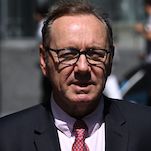Each week, Big Issues focuses on a newly released comic-book issue of significance. This week, it’s Prophet: Earth War #6. Written by Brandon Graham and Simon Roy with art by Graham, Roy, Giannis Milonogiannis, and Grim Wilkins, and colors by Graham, Joseph Bergin III, and Lin Visel, this issue concludes one of Image Comics’ best series by spotlighting all the stories still left to be told. (This review reveals major plot points.)
Prophet doesn’t get mentioned enough in discussions of the current Image Comics renaissance, but it’s been a groundbreaking title for the publisher. In the wave of exceptional new series released by Image over the last four years, Prophet is distinct, because it has a strong connection to the publisher’s origins, revamping the superhero character created by Rob Liefeld in the pages of Youngblood and using John Prophet as the foundation for a dramatically different narrative brought to life by creators with strong individual voices. Prophet was one of five books that were part of Image’s revival of Liefeld’s Extreme Studios in 2012, and it’s the only one that lasted for a significant period of time. Youngblood, Supreme, and Bloodstrike made very little impact, and while Joe Keatinge and Sophie Campbell’s Glory was a fascinatingly twisted superhero family drama, it only ran for 12 issues, while Prophet ran for 33.
At the heart of Prophet’s success is Brandon Graham, who has written or co-written almost every issue (Simon Roy handled Prophet #32 on his own), provided art breakdowns, and contributed interior artwork at various points throughout the series. Graham would take issue with having the book’s success solely attributed to him, though, because Prophet is such a group effort. Graham spearheaded the revival, but from the beginning he’s been adamant about giving his artistic collaborators greater influence on the series beyond just the visuals. Simon Roy was originally only credited as an artist, but he had important input on the development of the plot, which eventually gained him a story writing credit. Graham and Roy turn to their artists for inspiration, and that collaborative spirit has brought depth and excitement to the storytelling as the creative team works on material it is genuinely passionate about and personally invested in.
Prophet was on The A.V. Club’s Best Of Comics lists for three years in a row, and after no new issues in 2015, the series returned without any dip in quality with the Prophet: Earth War miniseries. Delays have had a negative impact on the story’s momentum from issue to issue (it’s been almost four months since the last chapter), but reading all the issues of Earth War in one big chunk shows that the delays don’t diminish the power of the book’s content. Having the freedom to take that extra time has allowed the creative team to maintain that standard of excellence throughout, and this week’s final issue is a poignant conclusion that serves as an effective thesis statement for the entire run.
Most of Prophet: Earth War #6 wraps up the titular conflict on the planet where all of this madness started, and the creative team delivers explosive sci-fi spectacle as the Prophets complete their mission to dismantle the Earth Empire. It’s a fairly conventional battle realized with intense energy by Roy, Giannis Milonogiannis, and Grim Wilkins (along with colorists Joseph Bergin III and Lin Visel), but the fight is just a precursor to the real meat of the issue: the nine-page ending sequence that highlights the elements that have made this series so compelling.
One of the most remarkable things about Prophet is the sense of history the creative team has brought to this sprawling sci-fi universe, taking the seed of Liefeld’s original Prophet idea and growing it into an expansive mythology that is far removed from its superhero beginnings. The final sequence of Prophet: Earth War #6 focuses on that history, jumping backward and forward in time with each panel to offer quick snapshots of various moments in the millennia-spanning timeline of this series. Milonogiannis draws the first panel of Old Man Prophet and his great love, Yiara, a thousand years ago, which makes for a smooth transition from the preceding scene (also drawn by Milonogiannis) to the new story structure of the final sequence.
Roy wraps up the rest of that page with three flashbacks—Diehard 4,400 years ago with his alien family, Rein East with her clan four years ago, the construction of the Towers Of Thailu Vah 7,000 years ago—and then Roy and Graham alternate panels for the next four pages, jumping among past, present, and future to let readers know that, although this run may be ending, there are still plenty of stories left to be told in this universe. Prophet’s power comes from this sense of endless possibility, and there’s no need to be limited by superhero conventions when there are so many more narrative opportunities to explore in comics. The original Prophet series was born from those conventions, but Liefeld gave this new creative team total freedom to take his concept in whatever direction they wanted, turning this dusty ’90s property into one of the best comics of the decade.
In the first five pages of the closing sequence, the creative team bridges the gap between Prophet’s superhero past and sci-fi present. Flashbacks to over 10,000 years ago spotlight superhero elements with glimpses of the superhero team Youngstar and the moment when Diehard killed the first John Prophet, but as the timeline moves forward, there’s an influx of sci-fi concepts that show how this universe gets stranger and more imaginative as it expands. And it will keep expanding after the destruction of Earth Empire, as evidenced by the flash-forwards to alien treasure fleets dissembling the remains of Earth and Old Man Prophet waking up once more to continue his never-ending fight.
After those five pages comes a two-page spread of the star-speckled cosmos, and assorted dots are circled and given labels describing major events that happen at each. This is a clever way of spotlighting letterer Ed Brisson’s talent—the sharp-angled font he uses for these labels has helped reinforce Prophet’s futuristic atmosphere for the entire run—but more importantly, the star-spread bolsters the idea that there are stories within stories within stories, just waiting for someone to tell them. So much of Prophet’s appeal has come from the delight of being dropped into these various worlds without much hand-holding from the creative team, and this image of a universe full of stories leaves readers with the message that there is always more to explore.
The starscape would be a satisfying final tableau, but Graham and Roy still have one more moment to show before saying goodbye. Prophet ends at the beginning with a two-page spread flashing back to four years ago, when an Empire hyberpod broke through the Earth’s surface to kick off a new era for this series. This image of where the book began reminds the reader of just how far Prophet has come from those mysterious, atmospheric first issues, but it’s also a visual driven by the idea of breaking out and venturing into a brave new world. This creative team busted through Prophet’s old foundation to explore brand-new narrative territory, taking readers on an unforgettable journey that will continue to reap rewards for years to come.







































